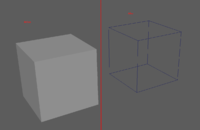Hey is there a way, a formula, to get a continuous line on a three-dimensional object along the edges of the object?
I basically have the position of all vertices and need a continuous line of going over each edge.
So that the result is a 'hollow' version of it.
I can basically go an infinite time over each edge, even two times over the same, but the the less the better. So there is definitely an answer but I do no know how to find.
See the screenshots for what I mean.
I basically have the position of all vertices and need a continuous line of going over each edge.
So that the result is a 'hollow' version of it.
I can basically go an infinite time over each edge, even two times over the same, but the the less the better. So there is definitely an answer but I do no know how to find.
See the screenshots for what I mean.

